![]()
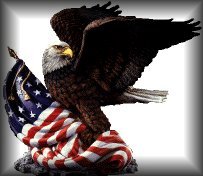
1620. The Mayflower - William White .
William White was a passenger on the Mayflower in 1620 and he died in the first winter, on the same day as three other passengers, including William Mullins. Susanna White wife of William gave birth to their son Peregrine while the Mayflower was still anchored off the top of Cape Cod waiting for the Pilgrims to discover a place to build their colony. Peregrine White was the first European child to be born in America.
The birthplace of William White has not been identified?
![]()
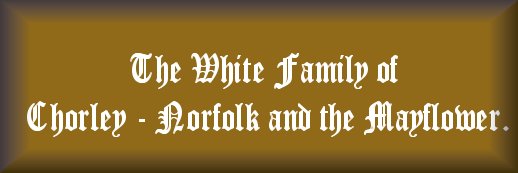
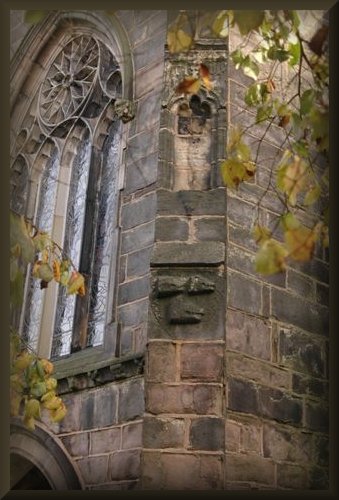
The Arms of the White Family on the Church Tower of St. Laurence.
John Wilson states in his book "Chorley Church" published in 1914 that the Church of St Laurence had a window with the White Family Coat of Arms in it. The Arms figured on the surcoat of a gentleman in armour were the same as those carved on the buttresses of the Church Tower.
“There was a window in which
was figured " a man knelynge armed w' these armes on him [Gules 3 boars'
heads couped argent tusked or, within a bordure engrailed of the second] and in
divers buttras cut in stone”.
John Wilson also states the precise
date that the Arms were granted and the name of the official record -:
"These arms were confirmed by
Dethick, Garter King at Arms to John Wight,1 of London, 2 Feb. 30
Eliz. 1588. And in that sumptuous volume, "Some Feudal Coats of
Arms," by Joseph Foster, we find : " White, Sir John (whyght) of Norfolk (Ed. II Roll) bore,
gules, a chevron between three boars' heads couped argent".
This clearly indicates that the Church Tower built and paid for by the White family could not have been built before February 2nd 1588.
Another point that John Wilson makes
is in regards to several other Whites in Lancashire – “There were Whites in
Lancashire in the fourteenth century: in the Lay Subsidy Roll for the County in
1322 we find Robert le White of Great Crosby and Roger le White of Great
Eccleston paying 3 shillings each, John le White of Bispham with Northbreck, 18
pence”.
The Norman French use of names can cause problems in determining a name as a family surname or the name of the Occupation of an individual - John
le White or John the White .One of the many early forms of spelling
White is WRIGHT an occupational name such as Plough Wright – Millwright.
![]()
White - Wrygth - Wyt - Witte Surname or Occupation ?
In Standish deed 88 below this
problem is indicated in the work or two of the Great researchers J.P. Earwaker
who transcribed the deed and the Rev. T.C. Porteus who edited the deed!
This deed clearly indicates the
name Wrygth as occupational. Over a period of time occupational names
became surnames in their own right but in 1366 the transition was in its
infancy. So what was Henry the Wrygth original surname?
Standish deed 64. Dated 6th
May 1351 gives us a clue.
To this deed is still attached a
round seal of brown wax, on a shield, a chevron between quatrefoils or bluebottles
slipped. The arms “resemble” those of the Chorley family. The legend is indistinct: S: Ricardi: de : Tho (?)... 9J X
5§. Earwaker : *XXXVII
The above Standish deeds are
legal statements of title to land and property detailed within them. The deeds
also contain a brief history of the past title owners. None of the Standish
title deeds referring to the Wrygth or Witte family of Shevington include any
reference to the de Chorley family the Lords of the Manor of Chorley. Thus the
question to be answered is - how does the seal of a junior member of the de
Chorley family become attached to this deed transferring the title to lands in
Shevington to the Standish family? The only legal answer based upon the old
English rule of Law the balance of probability is that Margaret
daughter of Adam de Sotlesworth in pure widowhood is the
widow Margaret Witte married into the Witte family – the Wrygh -Witte or White name is
occupational as indicated by Earwaker and Porteus and thus the real family
surname is confirmed by the seal attached to the deed on the 6th May 1351 – de Chorley..
Thus Henry the Wrygth would be
Henry de Chorley le Wrygth.
![]()
2. The White family - Church of St. Laurence – Chorley – The Mayflower.
Death record - "Puer Willi White Paragrine" - recorded in the parish register 2nd April 1641.
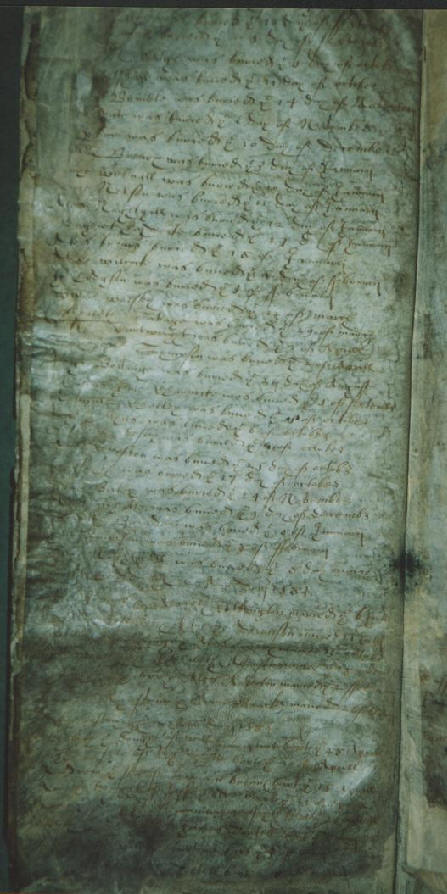
The parish register for1641 - page 99 (original page survives)
St. Laurence, Chorley, Lancashire
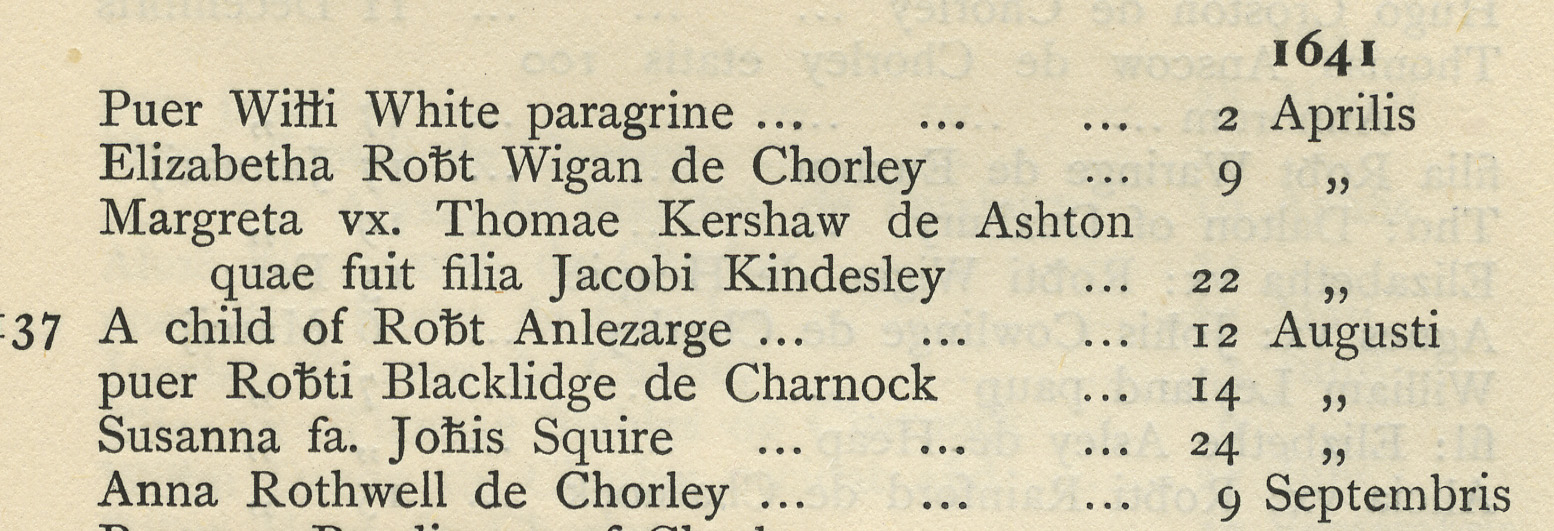
The parish register for1641 page 99 printed extracts 1920.
The documentation and information relating to the White family who built and paid for the Church Tower of St. Laurence in 1588 puts the Town of Chorley in prime position as the birthplace of William White passenger with Myles Standish on the Mayflower. The need in the new world for the skills of a Wright such as those possessed by many generations of the White family and the military skills of soldier Myles Standish were imperative to survival.Thus the presence of these two men with complementary skills on the Mayflower was not just an act of God but also a matter of sound business practice, which brought together two men born in the same County of Lancashire possibly known to each other and employed on the same venture. Susanna White wife of William gave birth to their son Peregrine while the Mayflower was still anchored off the top of Cape Cod waiting for the Pilgrims to discover a place to build their colony. Peregrine White was the first European child to be born in America.
![]()
Biographical Information provided by Caleb Johnson of the USA indicates that the birthplace of William White the father of sons Resolved and Peregrine is unknown.
|
Born: Unknown. |
|
Marriage:
|
|
Death: 21 February 1620/1, Plymouth. |
|
Children: Resolved, Peregrine. |
William White is a difficult individual to research, and much as been mispublished about him.
There is a marriage record in Leiden, Holland,which records the marriage of a William White to Anna Fuller on 27 January 1612; the marriage was witnessed by Sarah Priest and Anna's brother Samuel Fuller. For many years this was thought to have been the Mayflower passenger, Susanna and Anna being reasonable variants of the same name. This has been a heavily-debated issue: was this the marriage of the Mayflower passenger, or not?
There are at least two William White's living in Leiden during the appropriate time period, one was a woolcomber, and one was a tobacco merchant. The William White who married Anna Fuller was called a woolcomber in the 1612 marriage record, which was witnessed by Sarah Priest. On 10 April 1621, well after the Mayflower had departed, William White woolcomber was a party to the antenumptual agreement of Samuel Lee in Leiden. Thus, William White, woolcomber, could not have been the Mayflower passenger. And since Sarah Priest had witnessed the will of William White in 1612, wouldn't it be reasonable to assume it was the same William White who witnessed her own marriage to Godbert Godbertson in Leiden in October 1621? The Mayflower passenger was also not the tobacco merchant, who appears in numerous Leiden records throughout the 1620s.
So there was either a third William White in Leiden, or else the William White of the Mayflower may have joined onto the Mayflower's voyage from England. In any case, William and his wife Susanna came on the Mayflower in 1620 with son Resolved. Susanna gave birth to son Peregrine while the Mayflower was still anchored off the top of Cape Cod waiting for the Pilgrims to discover a place to build their colony.
William died the first winter, on the same day as three other passengers, including William Mullins. His wife
Susanna remarried to Edward Winslow a few months later, being the first
marriage to occur at Plymouth. - Caleb Johnson
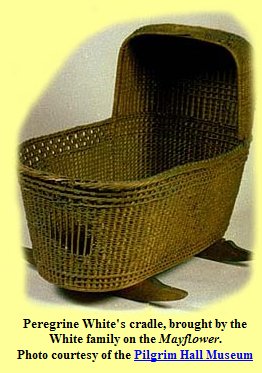
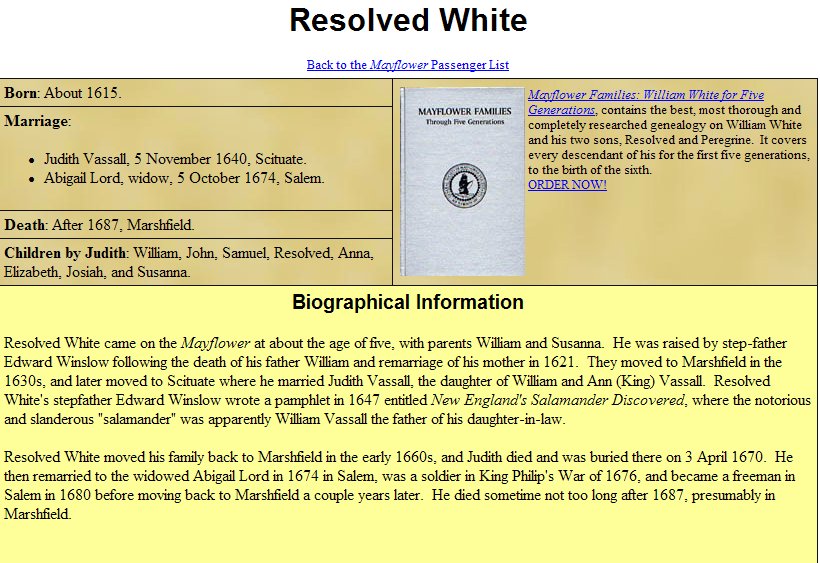
![]()